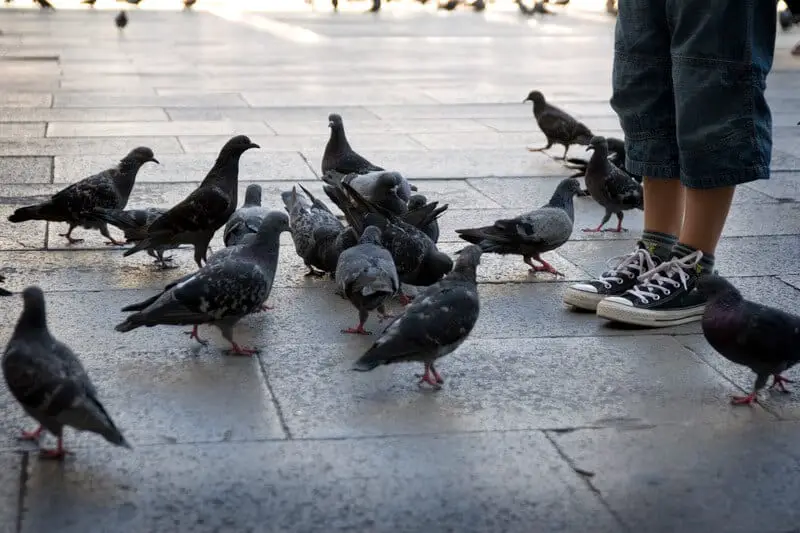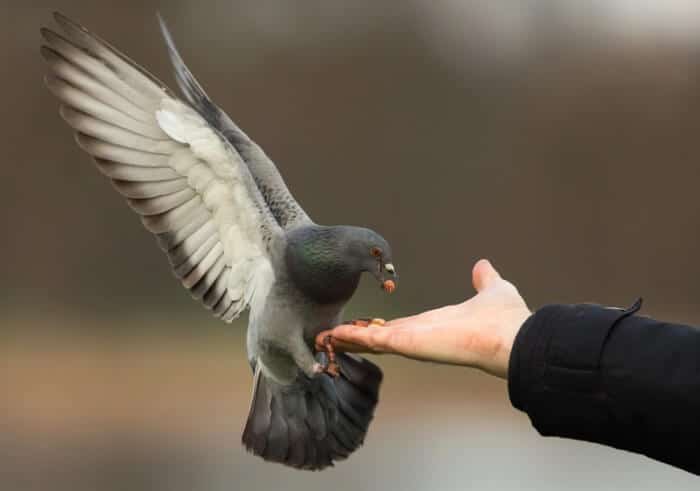Pigeons do often carry diseases and it is possible to catch a disease from touching one.
However unless you regularly handle pigeons it is unlikely that you will come into direct contact with one.
Pigeon Diseases
It is estimated that pigeons themselves carry up to 60 varieties of pathogens although the vast majority of them will not cause harm to humans.
As most of us don’t have any physical contact with pigeons, such as touching, these enter our bodies in other ways.

Pigeons pass on pathogens usually through their droppings. These droppings dry out, crumble, and become dust. This dust can be inhaled through the nose or mouth or ingested with food.
Some common diseases that can be passed on to humans from pigeons include:
1. Pigeon Fancier’s Lung
Pigeon fanciers and racing enthusiasts, on the other hand, have a great exposure to hypersensitivity pneumonitis, otherwise known as Pigeon or Bird Fancier’s Lung.
With constant contact, they inhale avian proteins from the feathers and droppings.
One study claimed that 31% of these British hobbyists had Pigeon Fanciers Lung.
It induces flu-like symptoms, such as dry coughing, aching bones, shortness of breath, and fever. It is treatable, but if neglected it can become fatal.
2. St Louis Encephalitis
St Louis encephalitis isn’t caught by direct contact with pigeons, but by mosquitoes that have fed on them and then on humans.
It causes an inflammation of the nervous system. The symptoms are drowsiness, fever, and headaches. It can be dangerous or even fatal to people over 60.
3. Histoplasmosis
Histoplasmosis is a respiratory disease that is caused by a fungus in pigeon droppings.
4. Candidiasis
Candidiasis is another respiratory disease that affects the lungs, mouth, and skin. Women are prone to have more problems with this than men.
5. E.Coli
E.coli is probably the most common disease that people have heard of and one of the most dangerous. It passes from pigeons to humans by way of wet droppings into food or potable water.
6. Salmonellosis
Salmonellosis is what we would call food poisoning. The particles from dried droppings are ingested with food.
7. Cryptococcosis
Cryptococcosis is a fungus found in both wet and dry pigeon droppings. It enters the body through the lungs and spreads.
Ulcers, acne, and skin eruptions result. It is very rarely serious unless left untreated but can possibly be fatal to those who have very weak immune systems.
How Bird Handlers Can Protect Themselves
Pigeon fanciers’, i.e. those that habitually come in contact in pigeons should take precautions when visiting a pigeon loft.
Regular sweeping out and general clean-up of the droppings is a must as a preventative measure.
It is also advisable to cover up.

Wearing overalls or boiler suits, face masks, gloves, and caps will lessen the chances of inhaling the infected dust of the droppings and proteins from the feathers.
There are manufactured disinfectants that you can purchase for an extra level of cleanliness.
How to Keep Pigeons Away
If you live in an area where there are plenty of pigeons there are numerous different pigeon deterrents and methods you can take to prevent them from plaguing you and your property.

Here are just a few:
- Spikes: either of steel or plastic can be placed on possible perches or nesting sites.
- Mesh or netting: to cover any openings where they might nest or perch.
- Decoys: replicas of owls and falcons.
- Chimney cowls: designed to fit over chimney pots prevent birds from nesting in or on your chimney while still allowing smoke to flow.
- Audio: sound makers to scare them off.
- Visual: bright flashing or blinking images.
In Conclusion
It is very unlikely that feeding the birds in Trafalgar Square or any other well-known plaza around the world where pigeons congregate, would lead to the transference of any of the above-mentioned diseases.
Pigeons are shy of people and do their best to avoid them. One moment they are at your feet merrily pecking away at seeds, the next up in the air, too far away to touch.
Pigeons are swift and can turn aerial acrobatics. They tend to fly away from, not to people.
Sources:
